Fire Haired
Regular Member
- Messages
- 689
- Reaction score
- 32
- Points
- 0
- Ethnic group
- Celto-Germanic, Latino(~6%)
- Y-DNA haplogroup
- R1b Df27(Spain)
- mtDNA haplogroup
- U5b2a2(Prussia)
Sorry if this is totally messed up and if the paragraphs are stuck together. It is because my account is messed up and barely works.
Archaeology and common Y DNA in modern Indo European speakers which age estimates show migrations starting in certain areas 7,000-5,000ybp. Show that Indo European languages most likely started, or took off and spread from these areas.

I probably went to south on the map because that is were R1b1a2a L23 proto Germanic Italo Celtic R1b1a2a1 L51 father is most popular and may have originated. Traditionally in the Kurgan theory proto Indo European languages began around Bug Dniester culture in Ukraine about 7,000ybp and in Yamna culture in Russia and Dnieper Donets Ukraine starting about 5,600ybp. Since there are 6,000 year old Kurgans in both southeast Poland and Caucus that kind of extends were very very early Indo Europeans were to the Caucus and north mid east and deeper in Europe.
So far we know that R1a1a1 M417 is for sure a proto Indo European marker and is from the Dnieper Donets and Yamna Ukraine Russia area. Since about 30-50% Balto Slavic speakers have R1a1a1b1 Z283 and anywhere from 10-40% Indo Iranian speakers have R1a1a1b2 Z93. The age estimates for them and their father R1a1a1b point to bronze age migrations from 6,000-4,000ybp.
Also Y DNA from supposedly proto Balto Slavic culture Corded ware two from 4,800ybp in Poland were G and I or J and two from 4,600ybp in central Germany were at least R1a1a M17. Seven Y DNA samples from 4,000 year old Tarim mummies in west China who were suspected to be connected with early Indo Iranian speakers all were at least R1a1a M17. Four 3,800-3,400 year old Y DNA samples from supposedly early Indo Iranian Andronovo culture in central Siberia three had at least R1a1a M17 and one had C probably from Mongoloid Siberians.
So Y DNA from cultures the Kurgan theory say were early Indo Iranian or early Balto Slavic speakers all back up the idea that R1a1a1 M417 is a early early Indo European Y DNA haplogroup from the Ukraine-Russia Bug Dniester-Yamna cultures. There is also a western European branch most likely from Germanic Italo Celts R1a1a1a L664. The proto Germanic Italo Celts were dominated by R1b1a2a L23 then R1b1a2a1 L51 but they probably picked up some R1a1a1 M417 since they were so close to other Indo Europeans in Russia Ukraine area 5,000-6,000ybp. So it seems they then formed their own branch. So the common ancestor of all those Indo European R1a branches is R1a1a1 M417.
Here is a migration map of Indo European R1a1a1 M417 made by Eupedia.
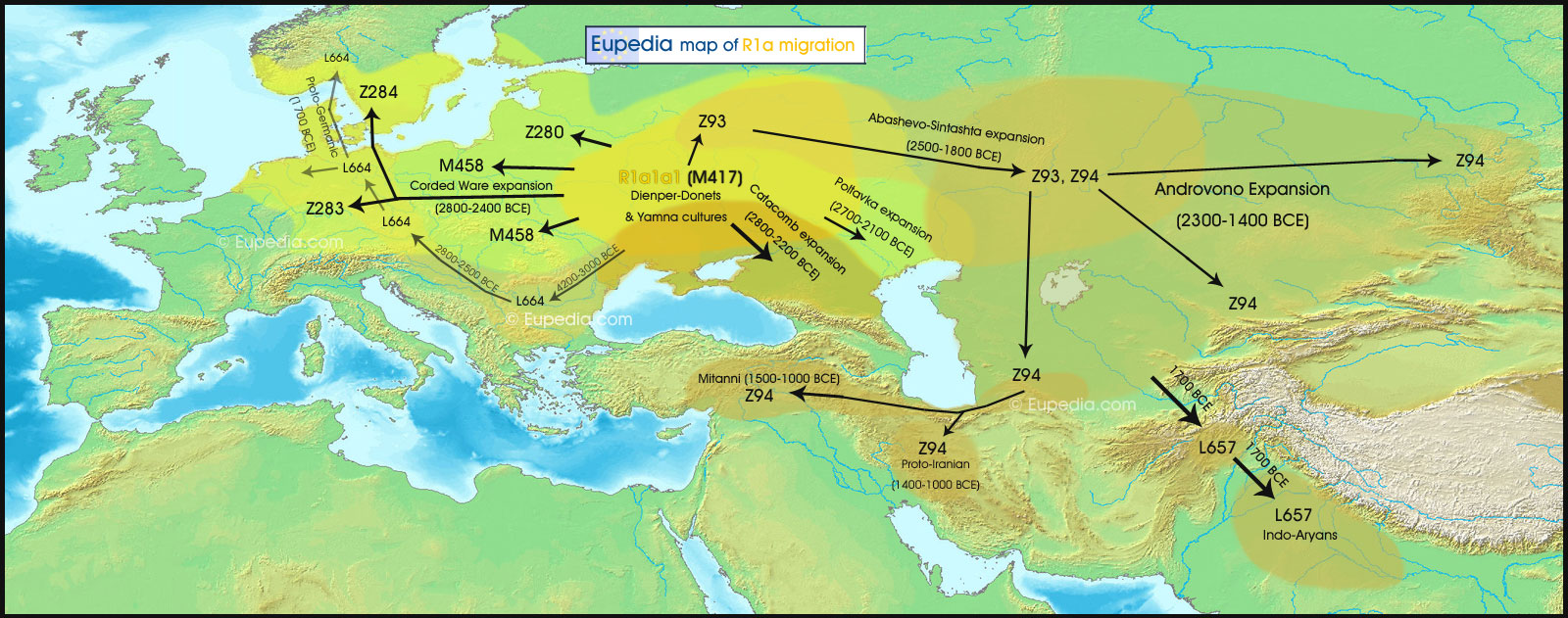
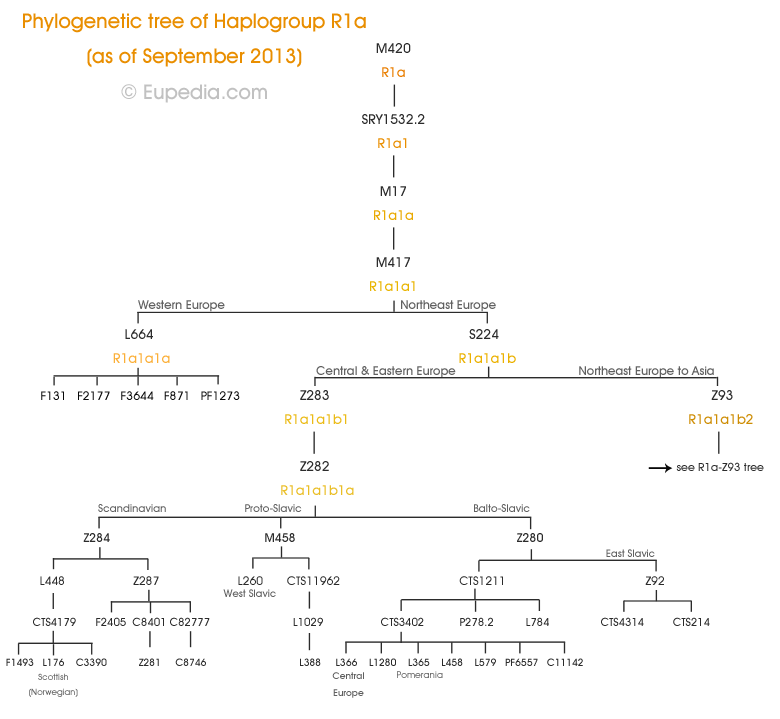
The other just about for sure Y DNA that spread with Indo European languages is Germanic Italo Celtic R1b1a2a1 L51. R1b L51-L11 Germanic Italo Celtc: Ruler and Conquers of Bronze-Iron age west Europe. What is weird is unlike R1a1a1 M417 which shows its origin in the traditional areas by the kurgan theory to be the Indo European homeland. R1b1a2a1 L51 father's seems to be from the middle east around Iraq, Anatolia, and the Caucus. It's father R1b1a2a L23 is centered in those areas and popular in the Balkans in southeastern Europe. I could not find any other info about the origin of R1b1a2a L23 but from what I have seen people say it comes from a migration out of the middle east.
Since there is a 6,000 year old Kurgan in the Caucus and Maykop culture (5,700-4,500ybp) in the Caucus and north eastern Anatolia. Shows very early Indo Europeans were in that area which could be were this R1b is from. And that those people had constant trade and contact with the Bug Dniester - Yamna people in Russia and Ukraine. I don't really know but since Germanic Italo Celt father R1b1a2a L23 is so popular even as south as Iraq makes me think that possibly Maykop had a origin around there and maybe proto Indo European or proto proto Indo European languages originated around that area.
R1b1a2a L23 then could be considered as a Indo European Y DNA haplogroup. But since it is so popular in areas that were never Indo European well I guess the Kurds and the Medes but they were Indo Iranians and we know have nothing to do with R1b1a2a L23. I think most is not Indo European. R1b1a2a2 Z2103 might be connected with Anatolian, Greek, and Indo European languages around the Balkans like Thracian-Dacian and Illyrian. Also R1b M73 shows connection of spreading with Indo Iranian languages but probably did not originate with Indo European speakers like R1a1a1 M417 and R1b1a2a1 L51 probably did.
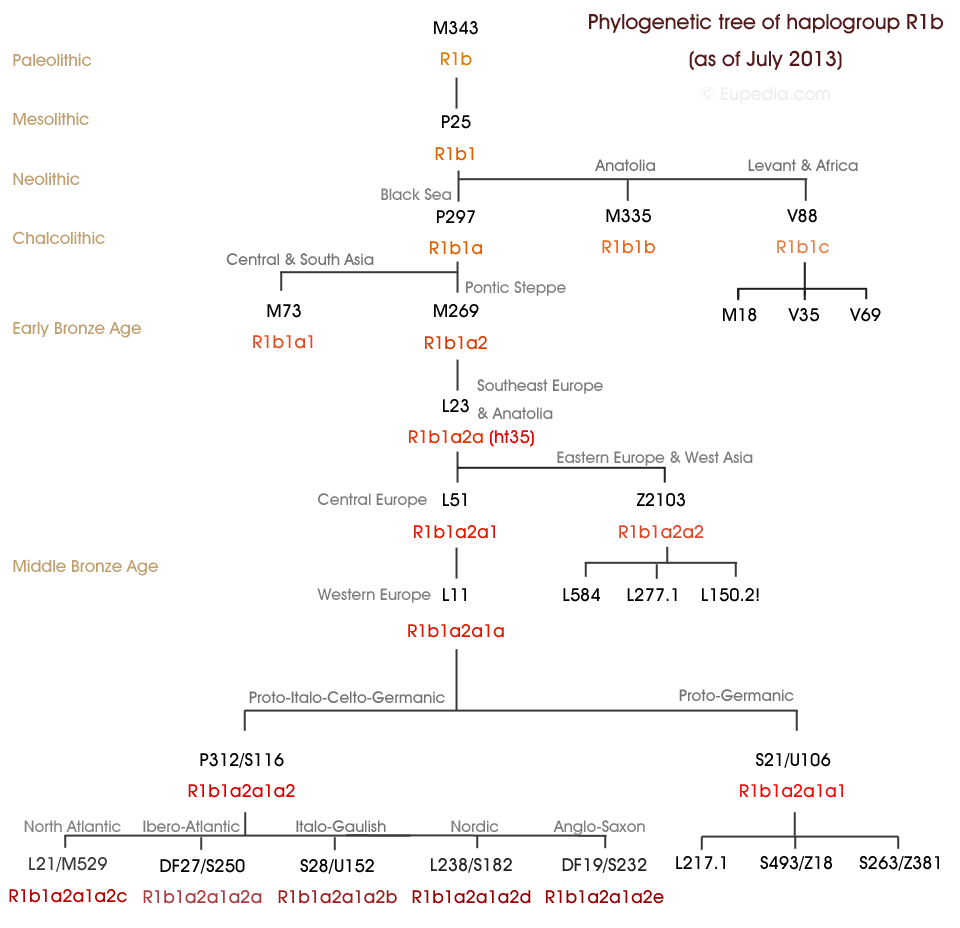
Eupedia migration map of R1b. I dis agree with R1b1a2 M269 originating in Europe. I think R1b made the same type of migration out of the mid east to Europe but as R1b1a2a L23.
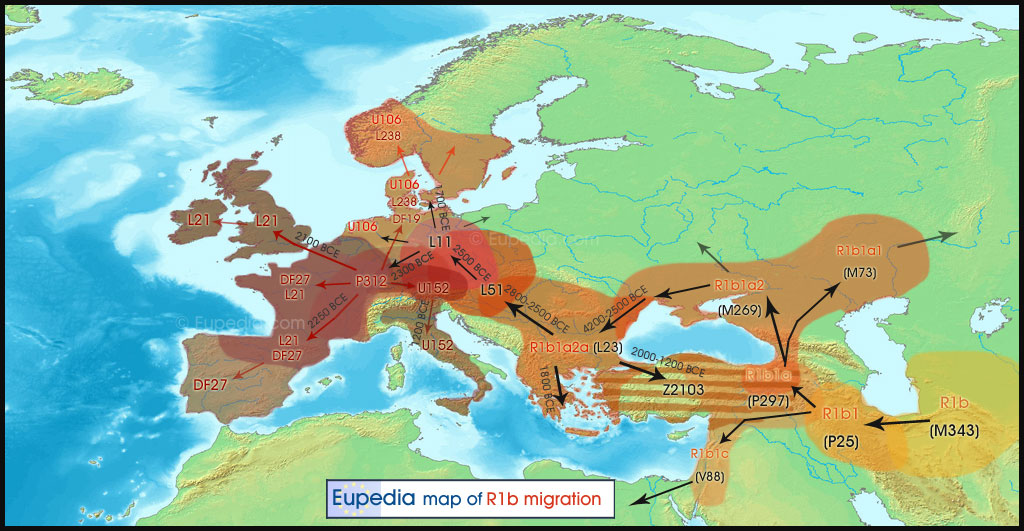
Here is a map of R1a in Europe. Almost all is under Indo European R1a1a1 M417. The vast majority is under Balto Slavic Corded ware culture R1a1a1b1 Z283.
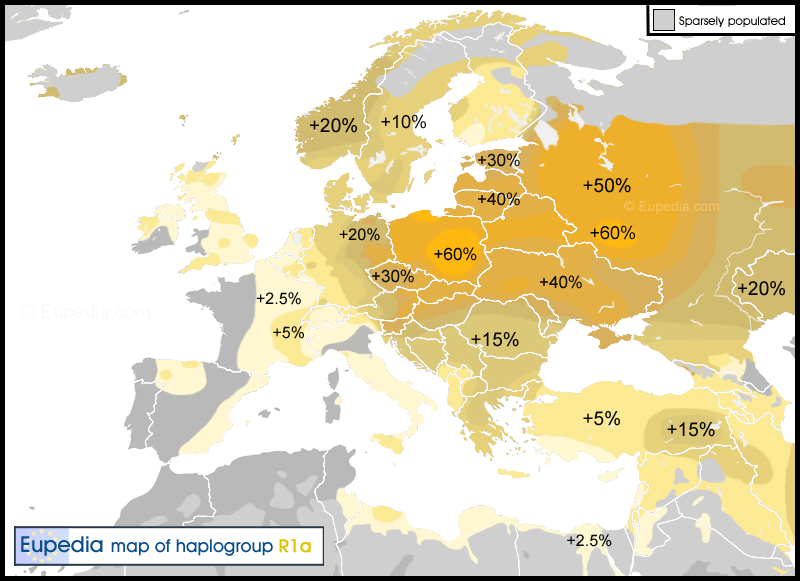
Here is a total map of R1a. Seems like who ever made this had less info than Eupedia. Almost all is under Indo European r1a1a1 M416 i already explained in Europe for Asia and parts of north eastern Europe it is just about 100% Indo Iranian R1a1a1b2 Z93.

Map of R1b in Europe. Almost all is under Germanic Italo Celtic R1b1a2a1 L51 except in the mid east, southeastern Europe, and Mediterranean were this is some R1b1a2a L23.
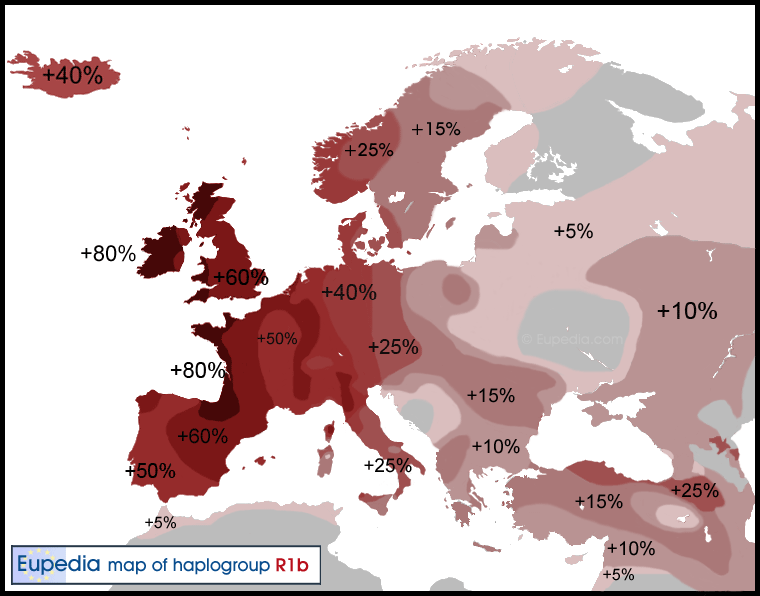
Map of Italo Celtic R1b1a2a1a1 S116/P312.
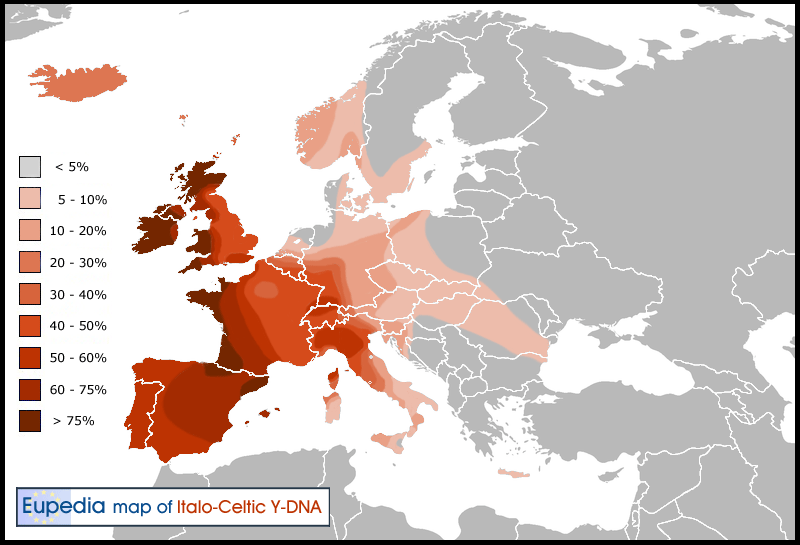
Map of Germanic R1b1a2a1a2 S21/U106.
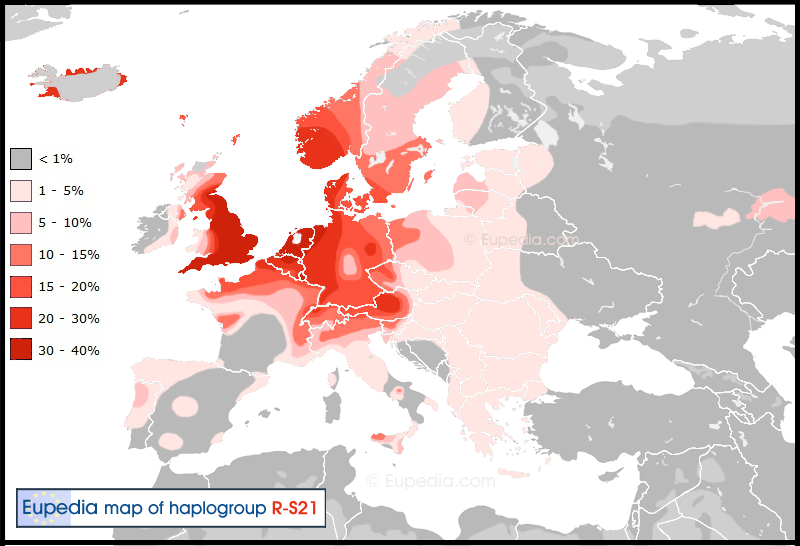
U can see by these maps Indo European Y DNA is extremely popular. The reason is Indo Europeans spread their language, culture, and religion almost only by conquest. So the native men were killed way more than the native women because they fought in wars and were seen as a threat. Also when Indo Europeans won they could force as many native women to be their wives. So they had way more offspring with the native women than Indo European women had with native men and in pretty much all cultures women are only allowed to have one husband while in some and alot of ancient ones men could have about as many wives and mistresses as they wanted. High ranking people and Chiefs sometimes had over 1,000 women. So this lead to Indo European speaking people direct male lineage to be heavily Indo European.
Indo European speaking people dont mainly descend from the first people to speak their language almost all mainly descend from people who lived in that area before their language spread, Except for maybe people in the British isles.
Archaeology and common Y DNA in modern Indo European speakers which age estimates show migrations starting in certain areas 7,000-5,000ybp. Show that Indo European languages most likely started, or took off and spread from these areas.
I probably went to south on the map because that is were R1b1a2a L23 proto Germanic Italo Celtic R1b1a2a1 L51 father is most popular and may have originated. Traditionally in the Kurgan theory proto Indo European languages began around Bug Dniester culture in Ukraine about 7,000ybp and in Yamna culture in Russia and Dnieper Donets Ukraine starting about 5,600ybp. Since there are 6,000 year old Kurgans in both southeast Poland and Caucus that kind of extends were very very early Indo Europeans were to the Caucus and north mid east and deeper in Europe.
So far we know that R1a1a1 M417 is for sure a proto Indo European marker and is from the Dnieper Donets and Yamna Ukraine Russia area. Since about 30-50% Balto Slavic speakers have R1a1a1b1 Z283 and anywhere from 10-40% Indo Iranian speakers have R1a1a1b2 Z93. The age estimates for them and their father R1a1a1b point to bronze age migrations from 6,000-4,000ybp.
Also Y DNA from supposedly proto Balto Slavic culture Corded ware two from 4,800ybp in Poland were G and I or J and two from 4,600ybp in central Germany were at least R1a1a M17. Seven Y DNA samples from 4,000 year old Tarim mummies in west China who were suspected to be connected with early Indo Iranian speakers all were at least R1a1a M17. Four 3,800-3,400 year old Y DNA samples from supposedly early Indo Iranian Andronovo culture in central Siberia three had at least R1a1a M17 and one had C probably from Mongoloid Siberians.
So Y DNA from cultures the Kurgan theory say were early Indo Iranian or early Balto Slavic speakers all back up the idea that R1a1a1 M417 is a early early Indo European Y DNA haplogroup from the Ukraine-Russia Bug Dniester-Yamna cultures. There is also a western European branch most likely from Germanic Italo Celts R1a1a1a L664. The proto Germanic Italo Celts were dominated by R1b1a2a L23 then R1b1a2a1 L51 but they probably picked up some R1a1a1 M417 since they were so close to other Indo Europeans in Russia Ukraine area 5,000-6,000ybp. So it seems they then formed their own branch. So the common ancestor of all those Indo European R1a branches is R1a1a1 M417.
Here is a migration map of Indo European R1a1a1 M417 made by Eupedia.


The other just about for sure Y DNA that spread with Indo European languages is Germanic Italo Celtic R1b1a2a1 L51. R1b L51-L11 Germanic Italo Celtc: Ruler and Conquers of Bronze-Iron age west Europe. What is weird is unlike R1a1a1 M417 which shows its origin in the traditional areas by the kurgan theory to be the Indo European homeland. R1b1a2a1 L51 father's seems to be from the middle east around Iraq, Anatolia, and the Caucus. It's father R1b1a2a L23 is centered in those areas and popular in the Balkans in southeastern Europe. I could not find any other info about the origin of R1b1a2a L23 but from what I have seen people say it comes from a migration out of the middle east.
Since there is a 6,000 year old Kurgan in the Caucus and Maykop culture (5,700-4,500ybp) in the Caucus and north eastern Anatolia. Shows very early Indo Europeans were in that area which could be were this R1b is from. And that those people had constant trade and contact with the Bug Dniester - Yamna people in Russia and Ukraine. I don't really know but since Germanic Italo Celt father R1b1a2a L23 is so popular even as south as Iraq makes me think that possibly Maykop had a origin around there and maybe proto Indo European or proto proto Indo European languages originated around that area.
R1b1a2a L23 then could be considered as a Indo European Y DNA haplogroup. But since it is so popular in areas that were never Indo European well I guess the Kurds and the Medes but they were Indo Iranians and we know have nothing to do with R1b1a2a L23. I think most is not Indo European. R1b1a2a2 Z2103 might be connected with Anatolian, Greek, and Indo European languages around the Balkans like Thracian-Dacian and Illyrian. Also R1b M73 shows connection of spreading with Indo Iranian languages but probably did not originate with Indo European speakers like R1a1a1 M417 and R1b1a2a1 L51 probably did.

Eupedia migration map of R1b. I dis agree with R1b1a2 M269 originating in Europe. I think R1b made the same type of migration out of the mid east to Europe but as R1b1a2a L23.

Here is a map of R1a in Europe. Almost all is under Indo European R1a1a1 M417. The vast majority is under Balto Slavic Corded ware culture R1a1a1b1 Z283.

Here is a total map of R1a. Seems like who ever made this had less info than Eupedia. Almost all is under Indo European r1a1a1 M416 i already explained in Europe for Asia and parts of north eastern Europe it is just about 100% Indo Iranian R1a1a1b2 Z93.
Map of R1b in Europe. Almost all is under Germanic Italo Celtic R1b1a2a1 L51 except in the mid east, southeastern Europe, and Mediterranean were this is some R1b1a2a L23.

Map of Italo Celtic R1b1a2a1a1 S116/P312.

Map of Germanic R1b1a2a1a2 S21/U106.

U can see by these maps Indo European Y DNA is extremely popular. The reason is Indo Europeans spread their language, culture, and religion almost only by conquest. So the native men were killed way more than the native women because they fought in wars and were seen as a threat. Also when Indo Europeans won they could force as many native women to be their wives. So they had way more offspring with the native women than Indo European women had with native men and in pretty much all cultures women are only allowed to have one husband while in some and alot of ancient ones men could have about as many wives and mistresses as they wanted. High ranking people and Chiefs sometimes had over 1,000 women. So this lead to Indo European speaking people direct male lineage to be heavily Indo European.
Indo European speaking people dont mainly descend from the first people to speak their language almost all mainly descend from people who lived in that area before their language spread, Except for maybe people in the British isles.

